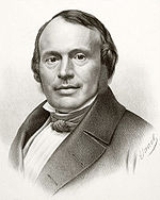
Louis Agassiz
Jean Louis Rodolphe Agassiz (1807-05-28 – 1873-12-14) was a Swiss-born American zoologist, glaciologist, and geologist and one of the first world-class American scientists. He was the husband of educator Elizabeth Cabot Cary Agassiz.
Sourced
- The time has come when scientific truth must cease to be the property of the few, when it must be woven into the common life of the world.
- Methods of Study in Natural History (1863), ch. 4
- The eye of the trilobite tells us that the sun shone on the old beach where he lived; for there is nothing in nature without a purpose, and when so complicated an organ was made to receive light, there must have been light to enter it.
- Geological Sketches (1870), ch. 2
- The facts will eventually test all our theories, and they form, after all, the only impartial jury to which we can appeal.
- Geological Sketches (1870), ch. 9
- The world has arisen in some way or another. How it originated is the great question, and Darwin's theory, like all other attempts to explain the origin of life, is thus far merely conjectural. I believe he has not even made the best conjecture possible in the present state of our knowledge.
- Evolution and Permanence of Type (1874)
Unsourced
- Every great scientific truth goes through three stages. First, people say it conflicts with the Bible. Next they say it has been discovered before. Lastly they say they always believed it.
- Alan L. Mackay, ed., A Dictionary of Scientific Quotations (CRC Press, 1991), p. 2 (Google Books version)
- Nothing more than a little shrimp-like animal, standing on its head in a limestone house and kicking food into its mouth
- Agassiz on barnacles
About Louis Agassiz
- Therefore, Agassiz says that when a new doctrine is presented, it must go through three stages. First, people say that it isn't true, then that it is against religion, and, in the third stage, that it has long been known.
- Karl Ernst von Baer, "Über Prof. Nic. Wagner's Entdeckung von Larven die sich fortpflanzen, und über die Pädogenesis überhaupt" (1866), trans. Stephen Jay Gould, The Structure of Evolutionary Theory (2002), p. 1021
